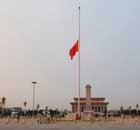Latest News
Fear of plague in quake-hit Qinghai
By Shan Juan (China Daily)
Updated: 2010-04-16 07:45
 |
Large Medium Small |
Hibernating marmots carrying fatal virus might wake up early
BEIJING - In the aftermath of the earthquake in Yushu, Qinghai province, health experts have sounded a warning of a possible outbreak of diseases, especially the fatal pneumonic plague.
Given that Qinghai has seen a sporadic rise in cases of the pneumonic plague in recent years, surveillance over the epidemic, which is passed on to humans by marmots, a type of ground squirrel indigenous to the region, has been strengthened to work out and implement effective measures to avert potential outbreaks.
Pneumonic plague, once established in a human population, is particularly virulent because it can be spread from person to person via coughing. If left untreated, mortality can range from 50-90 percent, according to the World Health Organization.
In 2004, eight villagers in Qinghai died of the plague. Most of them were infected after killing or eating wild marmots, which live in the grasslands of Northwestern China, where people hunt them for meat.
Contact with household animals like dogs, which get infected by eating the marmot, can also lead to human infection, experts warned.
To prevent infection, people, including rescue workers in the affected areas, should avoid contact with dead animals, Feng suggested.
He, however, maintained there was no reason for panic.
Currently, marmots are in hibernation and are expected to wake up in late April or early May, which, to a great extent, lessens the possibility of the plague spreading to humans, he said.
But he also conceded marmots might wake up earlier due to the impact of the massive earthquake, making epidemic prevention and control efforts tougher.
The last plague outbreak in Yushu occurred in the 1980s, Feng said.
To avert other disease outbreaks, like diarrhea, that commonly occur after an earthquake, the top health authority has outlined an epidemic control and response plan, including safe water and food distribution methods.
Besides, special attention should also be paid to prevent and control potential frostbite and heart/lung conditions related to high altitude among locals and relief workers, given the harsh natural conditions of the quake zone, experts said.
But "the top priority now is to pull out survivors from the rubble and save lives", Feng said.
A medical team organized by the Ministry of Health left Beijing for Yushu on Thursday morning.
Hundreds of medical workers from across the country, including doctors and nurses specializing in general surgery, neurosurgery, and pediatrics, were sent to Yushu with tons of relief materials.
Some 20 ambulances are also being transported to the quake-hit region from Beijing.
By Thursday, more than 500 injured had been transferred by air and railway to designated hospitals in the cities of Xining, Lanzhou, and Chengdu, according to the ministry.
Meanwhile, to secure a blood supply for the affected areas, more than 4,000 units of blood prepared by the provincial blood center of Qinghai, have been transferred to the site.
More than 5,000 units of blood are being kept aside as backup supplies in Beijing and Shanxi province.
China Daily













